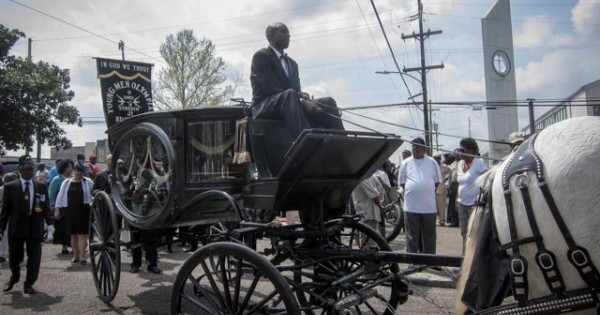
Alfred “Bucket” Carter died on March 9 at 80 years old. I never met him, unfortunately; virtually everything I know about him came from a lovely write-up in The Advocate by Katy Reckdahl. Carter worked at a warehouse for three decades, but was better known as a regular at the city’s Sunday second line parades. He’d been a member of the Young Men Olympian Jr. Benevolent Association since he was five years old, and attended many of the city’s second lines parades throughout the year. So, essentially, Carter had been dancing in New Orleans streets for three-quarters of a century. This seemed a life worth celebrating. It also seemed likely that his send-off would involve further dancing.
The services were already underway when I arrived at Israelite Baptist Church, and I milled outside with 200 or so other folks for nearly an hour. Some were dressed in their finest church clothes, but mostly people came as they were. Vendors were selling grilled sausages and $2 bottles of beer.
Shortly after noon, an elder emerged from the church and blew a whistle, and then a small brigade of men in black suits wearing somber black fezzes slowly emerged. They formed dual cordons, creating an open path through the crowd from the church door to an antique black hearse drawn by two white horses, its sides paneled in glass. The brass band took up near the hearse and started playing in the sun, filling the block with a slow dirge. The Young Men Olympians swayed in unison to the music, and the glossy black casket came down the steps and was loaded into the carriage.
A popular local bumper sticker reads, “We put the fun in funeral.” That’s overly glib, but it’s certainly the case that funerals here can involve equal parts mourning of a life departed, and the celebration of a life well-lived.
The procession set off, heading lakeward on Martin Luther King Jr. Boulevard. A band played “Just a Closer Walk with Thee,” and the association members took stately, intricately swaying steps, the tassels on their fezzes gently swinging. Reckdal wrote that “Carter taught younger members how to step to the slower dirges that bands played for funeral processions.” So, in a way, Carter was escorting himself.
The band was followed by the hearse, then the immediate family, and then another brass band. The crowd—the second line—fell in at the end. The procession turned left on South Liberty Street, and after a few blocks, it paused briefly in the street in front of the Young Men Olympians Jr. Benevolent Association Hall.
The group was founded in 1884, and is one of the few remaining benevolent associations in the city. Like the 70 or so of the social aid and pleasure clubs, they host an annual parade through city streets. Many of these clubs arose during the golden age of fraternal organizations, and were in large part a social safety net for African Americans, created at a time when banks and insurers shunned their business. The clubs pooled resources, and members might obtain small loans during hard times, or be assured of a decent burial when the time came. Loans and insurance are now more widely available elsewhere, but club members are still assured a proper sendoff. While many fraternal organizations nationwide are folding up as membership dwindles, dismissed by younger generations more into bowling alone and all that, the social aid and pleasure clubs as yet remain active and very much alive here. (How long these neighborhood-based groups will survive gentrification remains to be seen.)
I’ve been to several New Orleans funerals before this, and those involved dirges played the whole the way to the cemetery, with everyone moving at a measured pace. Once the casket was interred and goodbyes were said, the drums kicked up an up-tempo beat and the band launched into a lively number. Everyone danced back to the church for a repast.
This funeral was different. From the outset, the bands alternated between dirge and up-tempo on the way to the cemetery. Passing the association hall, everyone, including some of Carter’s family, broke into second line dancing both in front of and behind the hearse. Still, this seemed appropriate. Family members told Reckdahl that as Carter neared 80, they grew concerned about his sneaking out to the parades, fearful that he’d succumb to the heat and sun. “We would go to church and then he’d tell us he was going to visit his friends,” said his daughter Nitra Crowder. “When he came home, we’d find out he’d gone to the second line.”
Carter’s final second line finished up a few blocks away from the association hall, at Lafayette Cemetery #2, where he was interred in the tomb owned by the Young Men Olympians. Many of those assembled then began dancing their way back to the association hall to share in the repast. It was as good a demonstration as you’ll see that death can beget life.

